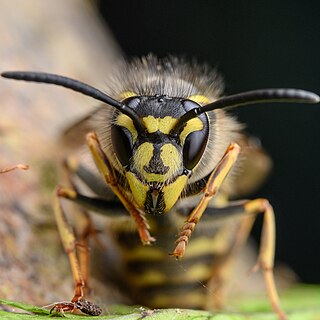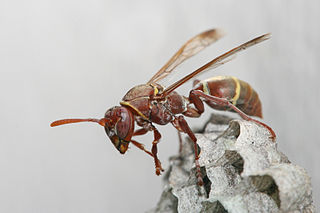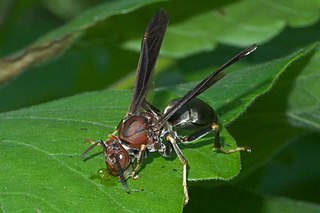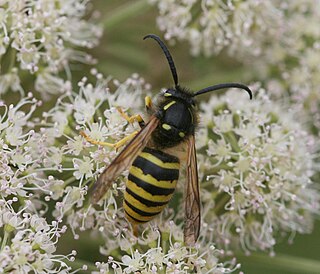
Vespula vulgaris, known as the Common wasp, is a species found in regions that include the United Kingdom, Ireland, Germany, India, China, New Zealand and Australia. It is sometimes known in English as the European wasp, but the same name is used for the species Vespula germanica or German wasp. In 2010, the ostensible Vespula vulgaris wasps in North America were found to be a different species, Vespula alascensis.

The Polistinae is a subfamily of eusocial wasps belonging to the family Vespidae. They are closely related to the more familiar wasps and true hornets of the subfamily Vespinae, containing four tribes. With about 1,100 species total, it is the second-most diverse subfamily within the Vespidae, and while most species are tropical or subtropical, they include some of the most frequently encountered large wasps in temperate regions.

Crematogaster ashmeadi, commonly known as the acrobat ant, is an arboreal ant widespread in the Southeastern United States. It nests and forages almost exclusively above ground level, often found in treetops and on lianas. It is one of eleven species in the genus Crematogaster that is native to eastern North America. This ant species has been observed to raid wasp nests, including the species Mischocyttarus mexicanus, and to forage on their brood. It is the most dominant arboreal ant in the pine forests of the coastal plains of northern Florida. Colonies of these ants inhabit a majority of pine trees in the area, living in chambers in the outer bark of living trees that have been abandoned by bark-mining caterpillars, usually of the family Cossidae. C. ashmeadi does little to no excavation of its own, relying solely on chambers bored out by other insects.

Ropalidia marginata is an Old World species of paper wasp. It is primitively eusocial, not showing the same bias in brood care seen in other social insects with greater asymmetry in relatedness. The species employs a variety of colony founding strategies, sometimes with single founders and sometimes in groups of variable number. The queen does not use physical dominance to control workers; there is evidence of pheromones being used to suppress other female workers from overtaking queenship.

Polistes metricus is a wasp native to North America. In the United States, it ranges throughout the southern Midwest, the South, and as far northeast as New York, but has recently been spotted in southwest Ontario. A single female specimen has also been reported from Dryden, Maine. Polistes metricus is dark colored, with yellow tarsi and black tibia. Nests of Polistes metricus can be found attached to the sides of buildings, trees, and shrubbery.

The tree wasp is a species of eusocial wasp in the family Vespidae, found in the temperate regions of Eurasia, particularly in western Europe. Despite being called the tree wasp, it builds both aerial and underground paper nests, and can be found in rural and urban habitats. D. sylvestris is a medium-sized wasp that has yellow and black stripes and a black dot in the center of its clypeus. It is most common to see this wasp between May and September during its 3.5 month colony cycle.

Polistes bellicosus is a social paper wasp from the order Hymenoptera typically found within Texas, namely the Houston area. Like other paper wasps, Polistes bellicosus build nests by manipulating exposed fibers into paper to create cells. P. bellicosus often rebuild their nests at least once per colony season due to predation.

Synoeca cyanea, commonly known as the marimbondo-tatu in Brazil, is a swarm-founding eusocial wasp. Native to Brazil and Argentina, S. cyanea is one of the largest and most aggressive species of social wasps and is feared in many rural areas. It begins its colony cycle in the early spring and continues until nest abandonment. Throughout its life, S. cyanea forage sugary substances and animal carcasses for food and wood pulp for its nest. S. cyanea is also known for its strong venom, which is enough to cause haemolytic activity.

Agelaia pallipes is a species of social paper wasp found from Costa Rica to Brazil, Argentina and Paraguay. A. pallipes is ground-nesting and is one of the most aggressive wasps in South America. This species is a predator of other insects, including flies, moths, and ground crickets, as well as baby birds.
Polistes pacificus is a Neotropical species of social paper wasp belonging to the subfamily Polistinae and the family Vespidae. P. pacificus can be found distributed throughout most of Central and South America and parts of southern North America. First discovered by Johan Christian Fabricius in 1804, P. pacificus is much darker in color than some other more recognizable Polistes wasps, and is one of the insects commonly eaten by several indigenous groups in Venezuela and Colombia.

Polistes biglumis is a species of social wasp within Polistes, the most common genus of paper wasp. It is distinguished mainly by its tendency to reside in montane climates in meadows or alpine areas. Selection pressure from the wasp's environment has led to several idiosyncrasies of its behavior and lifecycle with respect to its relative species in the genus Polistes. It alone among paper wasps is often polyandrous. In addition, it has a truncated nesting season that gives rise to unique competitive dynamics among females of the species. P. biglumis wasps use an odor-based recognition system that is the basis for all wasp-to-wasp interaction of the species. The wasp's lifecycle is highly intertwined with that of Polistes atrimandibularis, an obligate social parasite wasp that frequently invades the combs of P. biglumis wasps.
Mischocyttarus drewseni, which is sometimes spelled "drewsenii", is a social wasp in the family Vespidae. It is commonly found in Neotropical regions of South America, including Brazil, Peru, Venezuela, Colombia and Paraguay. This mid-sized wasp is about 1.5-1.8 cm and is typically dark brown or black in color. This species makes their nests out of woody plant fibers and create single combed nests with hexagonal cells which are typically found in low lying grass habitats or semi-urban environments. The colony cycle for this species is initiated by the queen who starts building the nest cell by cell. The nest construction process is highly elaborate and involves foraging for materials, creating cells, and heightening cell walls. It feeds on arthropods, plant nectar, and honeydew, and the species is very protective of its brood when it comes to defending them from their predators. The life cycle of this species has several stages with varying lengths, including egg, larval, pupal, and adult stages. As a social wasp species, there are several castes within the colony and different castes perform different specialized jobs with differing dominance and reproductive behaviors.
Protopolybia exigua is a species of vespid wasp found in South America and Southern Brazil. These neotropical wasps, of the tribe Epiponini, form large colonies with multiple queens per colony. P. exigua are small wasps that find nourishment from nectar and prey on arthropods. Their nests are disc-shaped and hang from the undersides of leaves and tree branches. This particular species of wasp can be hard to study because they frequently abandon their nests. P. exigua continuously seek refuge from phorid fly attacks and thus often flee infested nests to build new ones. The wasps' most common predators are ants and the parasitoid phorid flies from the Phoridae family.

Polybia sericea is a social, tropical wasp of the family Vespidae that can be found in South America. It founds its colonies by swarming migrations, and feeds on nectar and arthropods.

Mischocyttarus flavitarsis is a social paper wasp found in western North America. Their nests can be found both in forests close to rivers or in close proximity to human life under the eaves of roofs. Despite the fact that M. flavitarsis nests are frequently in close contact with humans, M. flavitarsis typically will not sting, but rather ram into the threatening individual. Their colony cycle typically begins before May and will last until October. The queen will then seek a hibernation site for the winter. Perched near female hibernation sites are males with whom the female will mate. The males have claimed their territory by rubbing sternal brushes along the border of the site, leaving a chemical that deters other individuals from approaching. M. flavitarsis feed on arthropods, nectar, and animal carcasses and are often prey to birds, ants, and praying mantis.

Polistes versicolor, also known as the variegated paper wasp or yellow paper wasp, is a subtropical social wasp within Polistes, the most common genus of paper wasp. It is the most widely distributed of South American wasp species and is particularly common in the Southeastern Brazilian states. This social wasp is commonly referred to as the yellow paper wasp due to the distinct yellow bands found on its thorax and abdomen. The P. versicolor nest, made of chewed vegetable fiber, is typically a single, uncovered comb attached to the substratum by a single petiole. The yellow wasp is frequently found in urban areas. New nests and colonies are usually founded by an association of females, sometimes in human buildings. The P. versicolor colony cycle broadly ranges from 3 to 10 months, although there appears to be no relationship between the colony's development and the season of the year. While yellow paper wasps do have clear annual colony cycles, many young queens have the opportunity to hibernate during the winter, forming optional winter aggregations. Dominance hierarchies within these aggregations are characterized by physical aggression of the dominant female(s) towards the associated females, who tend to be sisters. Wagging movements are also often used as a form of communication within the colony. The yellow paper wasp is generally predatory, capturing a wide range of insects, although it often feeds on pollen and nectar as well. Therefore, P. versicolor can be useful as a pollinator or as effective pest control.

Agelaia multipicta is a swarm-founding, highly eusocial wasp that lives in Mexico, Argentina, Trinidad and southern Brazil. It nests in natural cavities such as hollow trees and aggressively defends the nest from ants, who are brood predators. The workers and queens are morphologically distinguished by ovarian development as well as external features such as a larger petiole and gaster in the queen. Like other carrion-eating (necrophagous) wasp species, A. multipicta plays a scavenging role in the ecosystem. Agelaia multipicta was described by the Irish entomologist Alexander Henry Haliday in 1836.
Polistes erythrocephalus is a species of paper wasp in the subfamily Polistinae of family Vespidae found in Central and South America. P. erythrocephalus is a eusocial wasp, meaning that it possesses both reproductive and non-reproductive castes. The cooperation between the two castes to raise young demonstrates the altruistic nature of these wasps. P. erythrocephalus exhibits a four-stage colony cycle, as do many other Polistes wasps. This species generally feeds on larvae, occasionally their own, and is preyed upon by species such as army ants.

Mischocyttarus mexicanus is a New World species of paper wasp that exhibits facultative eusocial behavior and includes at least two subspecies living in the southern United States and Central America. This social wasp species is a good model for studying the selective advantage of different nesting tactics within a single species. M. mexicanus females can form nests both as individuals and as members of a colony, and are even known to switch between these two nesting strategies throughout their life, which is an unusual phenomenon in the field of social biology. Individuals in a colony have particular social roles that are plastic, as opposed to rigid castes, and brood parasitism and usurpation have been observed between unrelated conspecifics. They nest in a variety of types of plants and human constructions, although they have most frequently been observed in palm trees, and they are known to interact with a number of other species as prey, competitors over resources, or foragers.

Pleometrosis is a behavior observed in social insects where colony formation is initiated by multiple queens primarily by the same species of insect. This type of behavior has been mainly studied in ants but also occurs in wasps, bees, and termites. This behavior is of significant interest to scientists particularly in ants and termites because nest formation often happens between queens that are unrelated, ruling out the argument of inclusive fitness as the driving force of pleometrosis. Whereas in other species such as wasps and bees co-founding queens are often related. The majority of species that engage in pleometrosis after the initial stages of colony formation will reduce their colonies number of queens down to one dominant queen and either kill or push out the supernumerary queens. However there are some cases where pleometrosis-formed colonies keep multiple queens for longer than the early stages of colony growth. Multiple queens can help to speed a colony through the early stages of colony growth by producing a larger worker ant population faster which helps to out-compete other colonies in colony-dense areas. However forming colonies with multiple queens can also cause intra-colony competition between the queens possibly lowering the likelihood of survival of a queen in a pleometrotic colony.
















